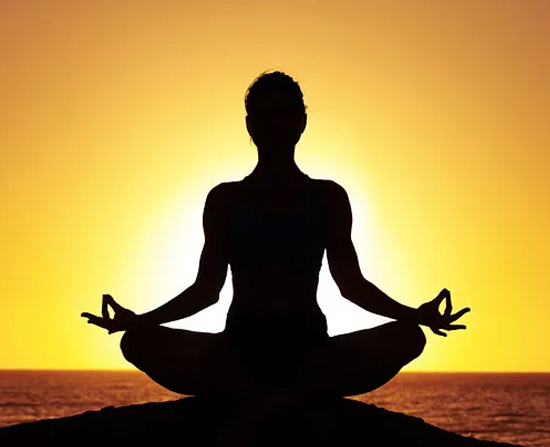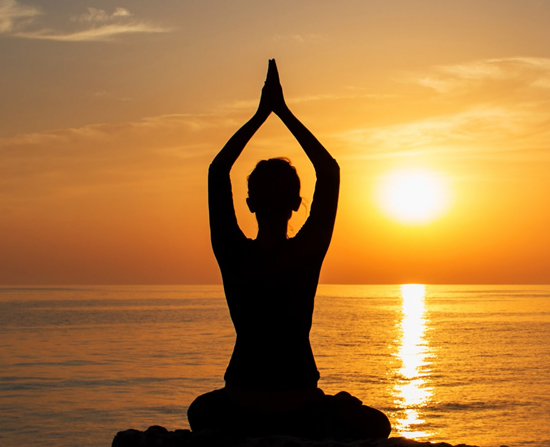
Mokshaa Yoga

Yoga Ayurveda
Yoga and Ayurveda are the unique science of antiquity.
Both were developed and practiced in similar circumstances with similar objectives
in the same land. It may be pointed that Yoga and Ayurveda both are based on similar
concept of human existence. Yoga and Ayurveda are allied disciplines. Both have
advocated Aushadhi, Mantra, Japa, Samadhi etc.as the means of achieving their
objectives. Besides spritiual paths, Yoga also teaches the use of drugs for
Chitta-shuddhi. Similarly, besides Aushadhi, Anna, Vihara ( drug, diets etc.)
Ayurveda also teaches the practice of Yoga. Thus there is a similarity in the
approach of these two human sciences, though the emphasis varies.
Charaka Samhita the most important treatise of Ayurveda is like the ocean of
knowledge. It is said that a single verse from Charaka Samhita can elaborate a full
treatise. Thus like Mahabharata Charaka also quotes-
यदिहास्ति तदन्यत्र यन्नेहास्ति न तत्क्वचित् । (च. सि. 12/54)
Thus it is treasure of knowledge from life science to philosophy. Charaka Samhita,
one of the foremost Ayurvedic classics, deals with the highest category of Yoga. The
Yoga Sutras is the most elaborate ancient work we have on Yoga Darshan. We owe much
to Maharshi Patanjali for his ability to collect and assess the later present a
workable Yoga system in his Yoga Sutras. Ayurveda an eternal system of medicine, is
known for it’s multidimensional approach towards mankind. Utility of this science
starts right from fertilization to death, personal to public hygiene, diet and
regimen to medicines and so on. Ayurveda and health are very closely related and
supplementary to each other. Ayurveda does not concern with physical health only but
spiritual and mental health also.
Physical and Mental health are interdependent and complimentary aspects of Ayurveda.
Mental health is not a stage free from mental ailment but a vision of life which can
be perceived in the total personality including thought process, emotions and minute
feelings. Charaka has stated the Mool Pravrutti of an individual is Sukh. The
criteria of Mental health are the definition of Sukhayu by Charaka ( Ch. Su. 22/4 )
. Satvasara is another concept which is very closer to the norms of Mental health as
Stated by western scientists in this regard.
युजिर योगे। (धातुपाठ 1469)
‘Yujira’ meaning to unite, to combine or to integrate
and thus may be taken to mean a state of union or integration i.e. the union of the
individual soul or consciousness with the cosmic, divine or supreme soul or
consciousness or a total integration of the physical, mental, intellectual and the
spiritual aspect of human personality. The word, Yoga appears to have been used very
profusely in Mahabharata to denote the way or means for achieving a goal or as a
means of achieving the state of self realization . The means and ways advocated by
Lord Krushna to the Pandavas for achieving the victory over the Kauravas which could
include the diplomacies of the war and the planning at the battle field1, all these
appeared to have been referred by the word Yoga.
Definition
The traditional concept of Yoga needs further exposition
in relation to the three traditional classics –
- The early Upanishad.
- Yogasutra of Patanjali.
- Bhagavadgita
The central theme of the concept of Yoga in early Upanishads is around the science
of meditation and self realization. The state of Yoga as conceived in Kathopanishad
and also in Maitriupanishad reads “that they say, is the highest state when the five
senses of knowledge together with the mind cease from their normal activity and the
intellect does not stir2. Yoga in Upanishadika contexts is related to spiritual
uplift and self realization including higher consciousness and awareness.

Classification of Yoga
Yoga is classified in different ways in different contexts by different texts.
A] Karma Yoga, Dnyana Yoga, Bhakti Yoga6.
B] Mantra Yoga, Laya Yoga, Hatha Yoga, Raja Yoga7.
C] Maha Yoga Consisting of above four as its components8.
Besides, a number of other categories of Yoga appear in different contexts. Each of eighteen chapters of Bhagvatgita has been named as Yogashastra and each chapter is named as Yoga. However, the eighteen chapters are not considered as eighteen varieties of Yoga but are usually classed in three groups i.e.viz. Karma Yoga, Dnyana Yoga, and Bhakti Yoga. Mantra Yoga refers to the achievement of certain Siddhis with the help of enchanting of certain Mantras of the goods like Brahma, Vishnu, Shiva etc9. Similarly Laya Yoga is the method of achieving certain Siddhis of Yoga by Getting oneself absorbed in the nine chakras10. Hata Yoga appears to have been described in detail in Yogatatvoupanishad. Hathayogapradipika considers Asana, pranayam, Mudra and Nada Anusandhana as the major Hatayoga practices and advocates that these Hathayogic practices may be practiced till the achievement of Rajayoga considering such practices as preparatory for Raja Yoga11.
Raja Yoga appears to be a term used for describing the most superior quality of Yoga. We find many controversies regardingon the nature of Raja Yoga. Yogashikhopanishad considers Raja Yoga as the union of the Rajas and the Retas12. Certain authors considering the Mana as the master of Indriyas accepts the Yoga of mind ( Raja ) i.e.Manovijaya as Rajayoga. However, conventionally the science and art of Yoga described by Patanjali is known as Rajayoga and generally it is called Raja Yoga because it ia the best quality of Yoga, although Patanjali himself has never named his system of yoga as Raja Yoga.
A] Karma Yoga, Dnyana Yoga, Bhakti Yoga6.
B] Mantra Yoga, Laya Yoga, Hatha Yoga, Raja Yoga7.
C] Maha Yoga Consisting of above four as its components8.
Besides, a number of other categories of Yoga appear in different contexts. Each of eighteen chapters of Bhagvatgita has been named as Yogashastra and each chapter is named as Yoga. However, the eighteen chapters are not considered as eighteen varieties of Yoga but are usually classed in three groups i.e.viz. Karma Yoga, Dnyana Yoga, and Bhakti Yoga. Mantra Yoga refers to the achievement of certain Siddhis with the help of enchanting of certain Mantras of the goods like Brahma, Vishnu, Shiva etc9. Similarly Laya Yoga is the method of achieving certain Siddhis of Yoga by Getting oneself absorbed in the nine chakras10. Hata Yoga appears to have been described in detail in Yogatatvoupanishad. Hathayogapradipika considers Asana, pranayam, Mudra and Nada Anusandhana as the major Hatayoga practices and advocates that these Hathayogic practices may be practiced till the achievement of Rajayoga considering such practices as preparatory for Raja Yoga11.
Raja Yoga appears to be a term used for describing the most superior quality of Yoga. We find many controversies regardingon the nature of Raja Yoga. Yogashikhopanishad considers Raja Yoga as the union of the Rajas and the Retas12. Certain authors considering the Mana as the master of Indriyas accepts the Yoga of mind ( Raja ) i.e.Manovijaya as Rajayoga. However, conventionally the science and art of Yoga described by Patanjali is known as Rajayoga and generally it is called Raja Yoga because it ia the best quality of Yoga, although Patanjali himself has never named his system of yoga as Raja Yoga.
Patanjali Yogasutra
1.Yogasutra :
Yoga means union, to join; it is the same as the absorption in the state of Samadhi. Sutra means thread, and this thread, or multiple threads weave a tapestry of insight and direct experience. Some say that the name of the text uses the word sutra in its plural form, as Yoga Sutras, in that each of the sutras, or threads, comes together to form a complete tapestry. Others say that it is used in its singular form, as Yoga Sutra, in that there is one , consistent thread that flows through the entire text. The word implies that the written word carry an underlying continuous thought , the various ideas connect together like beads on a mala to form a complete philosophy.
2.Period :
Yoga Sutras are thought to be as old as 560 BC, archaeological evidence and other texts suggest that he methods describes in the Yoga Sutras were being practiced as early as 3000 BCE. Oral tradition states that the period may be even longer.
3.Synonyms :
Yoga means union, to join; it is the same as the absorption in the state of Samadhi. Sutra means thread, and this thread, or multiple threads weave a tapestry of insight and direct experience. Some say that the name of the text uses the word sutra in its plural form, as Yoga Sutras, in that each of the sutras, or threads, comes together to form a complete tapestry. Others say that it is used in its singular form, as Yoga Sutra, in that there is one , consistent thread that flows through the entire text. The word implies that the written word carry an underlying continuous thought , the various ideas connect together like beads on a mala to form a complete philosophy.
2.Period :
Yoga Sutras are thought to be as old as 560 BC, archaeological evidence and other texts suggest that he methods describes in the Yoga Sutras were being practiced as early as 3000 BCE. Oral tradition states that the period may be even longer.
3.Synonyms :
- Raja Yoga ( Best quality of Yoga )
- Ashtanga Yoga ( Ashta – eight, Anga – Rungs ) Eight fold path of Yoga- Yama, Niyama, Asana, Pranayam, Pratyahara, Dharana,Dhyana, and Samadhi.
- Sankhya Pravachana ( detailed explaination of Sankhya )
- Seshwar sankhya
